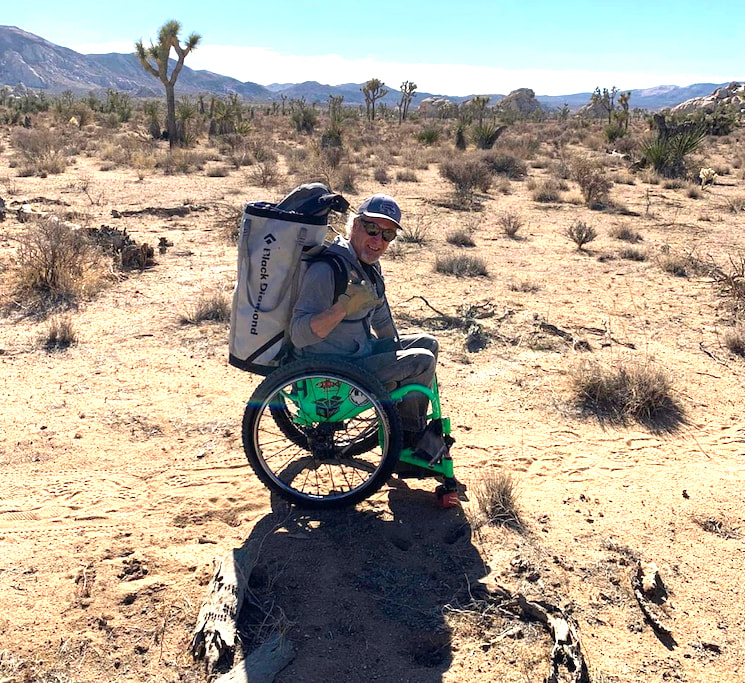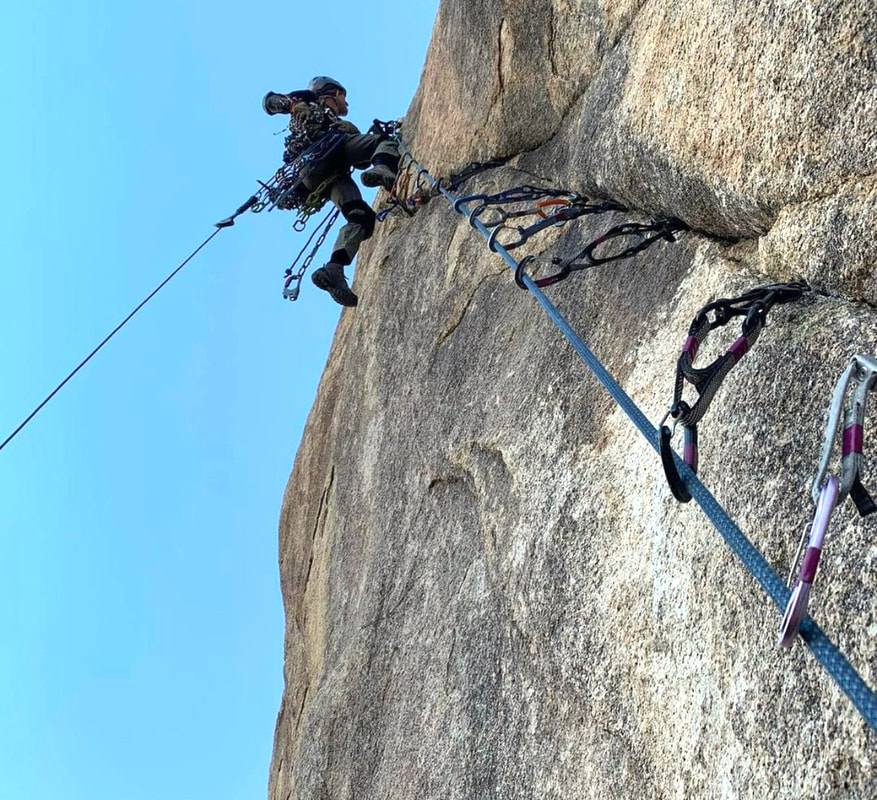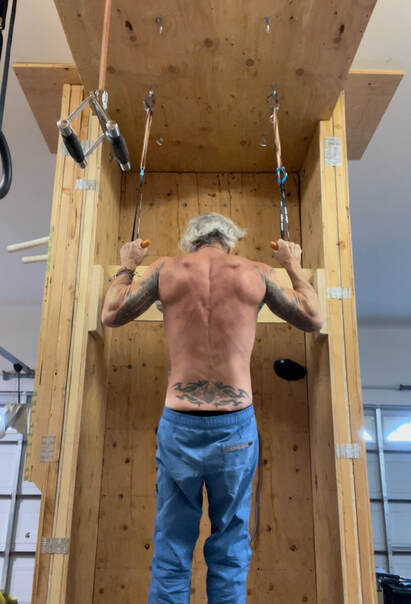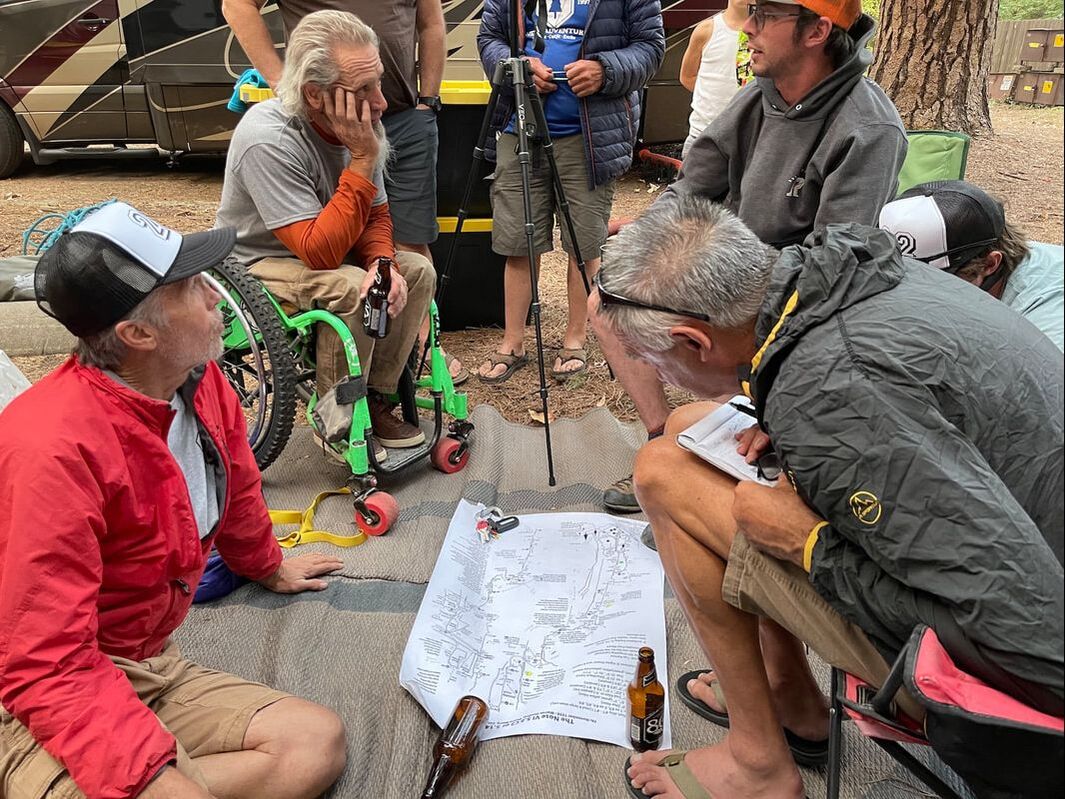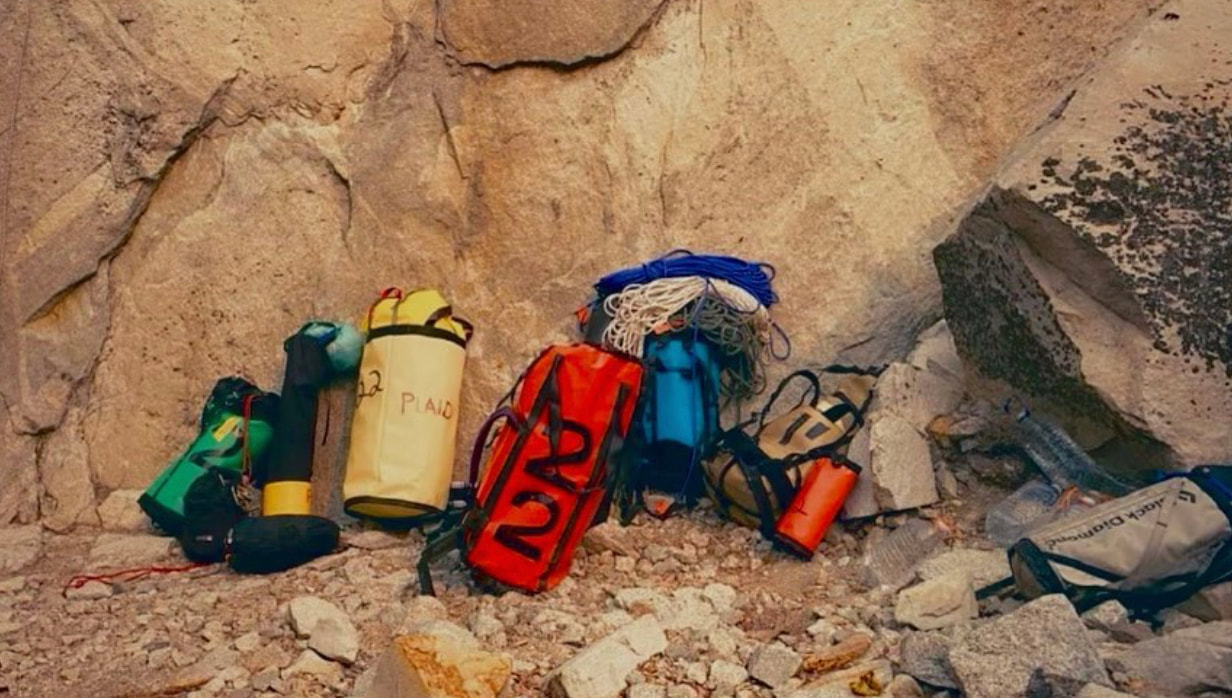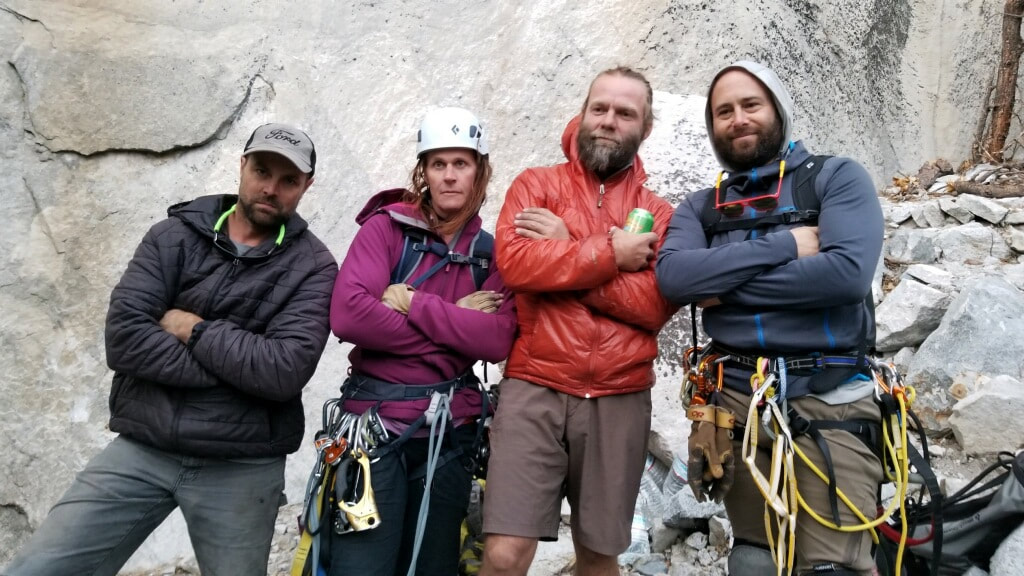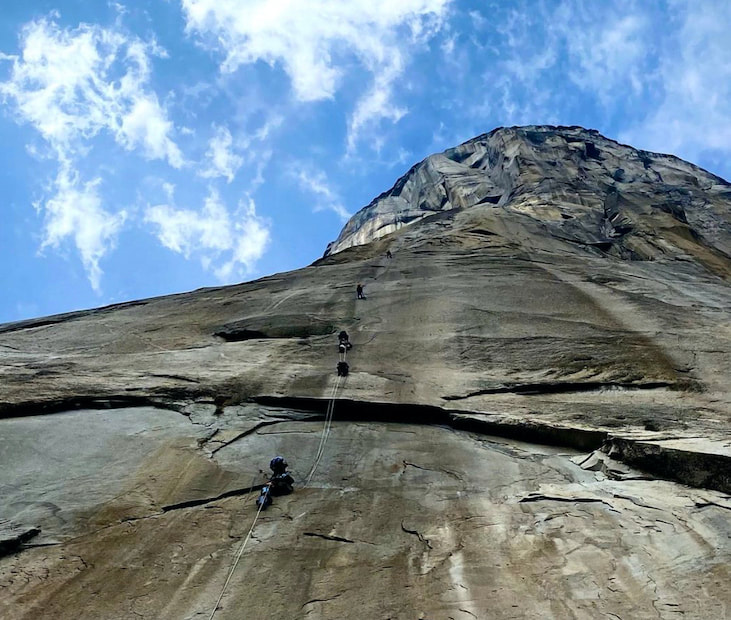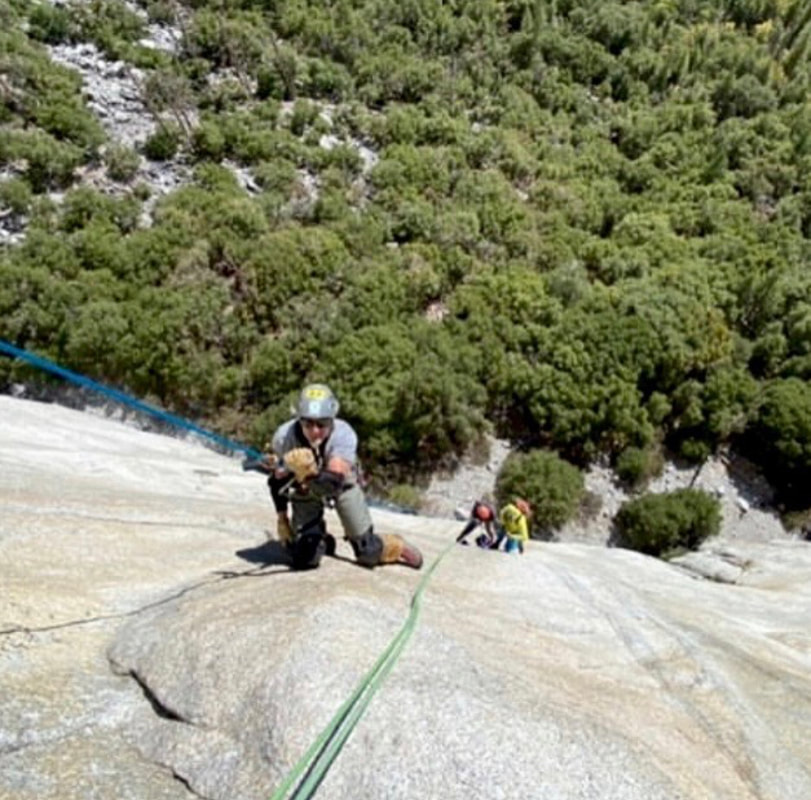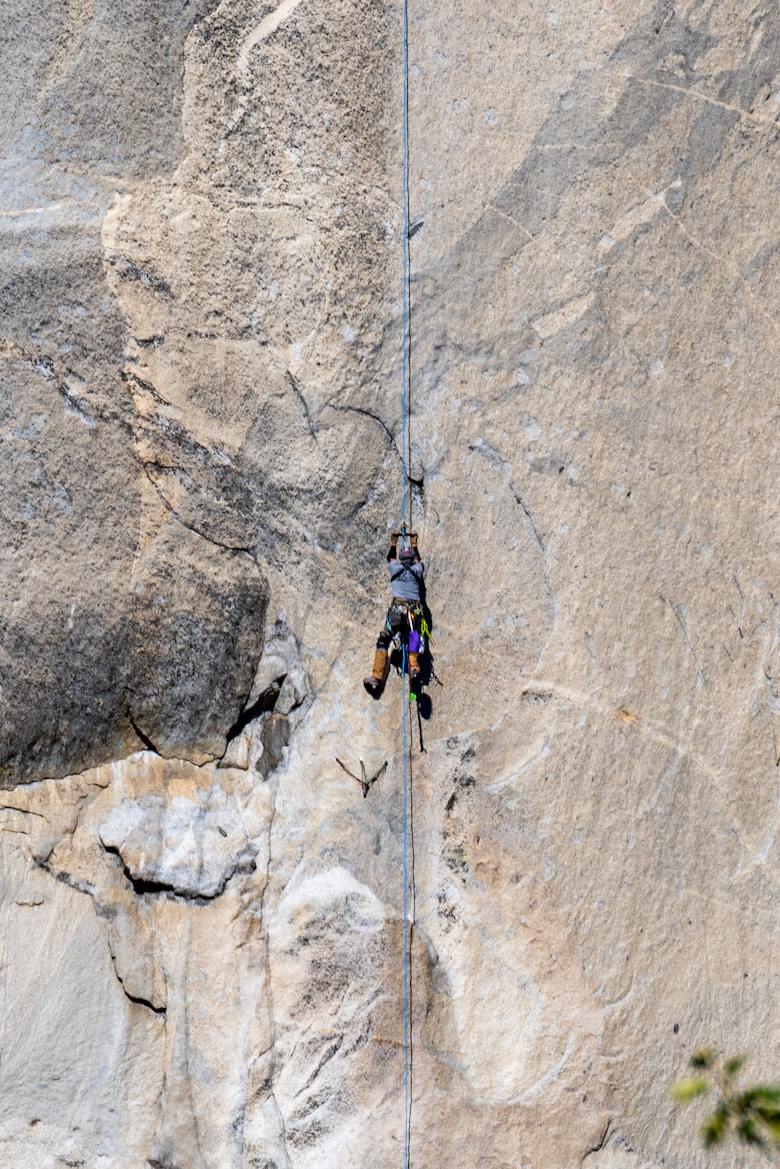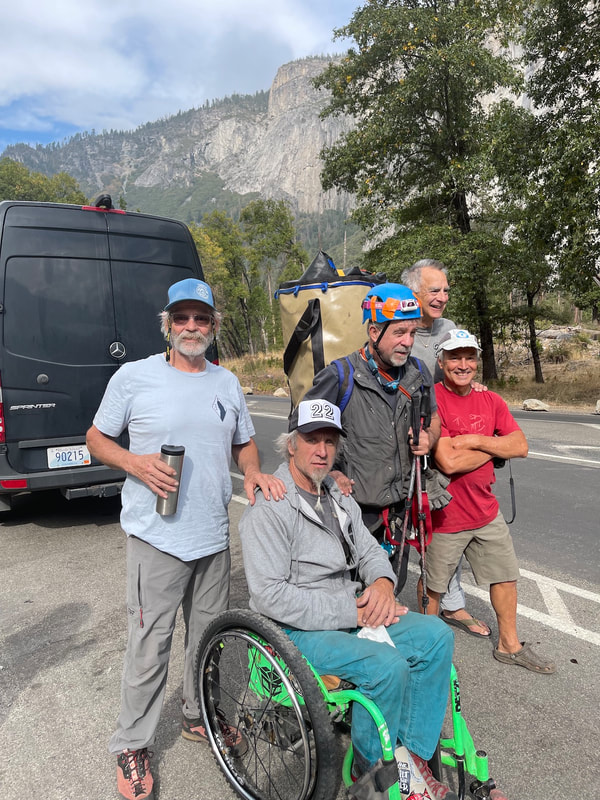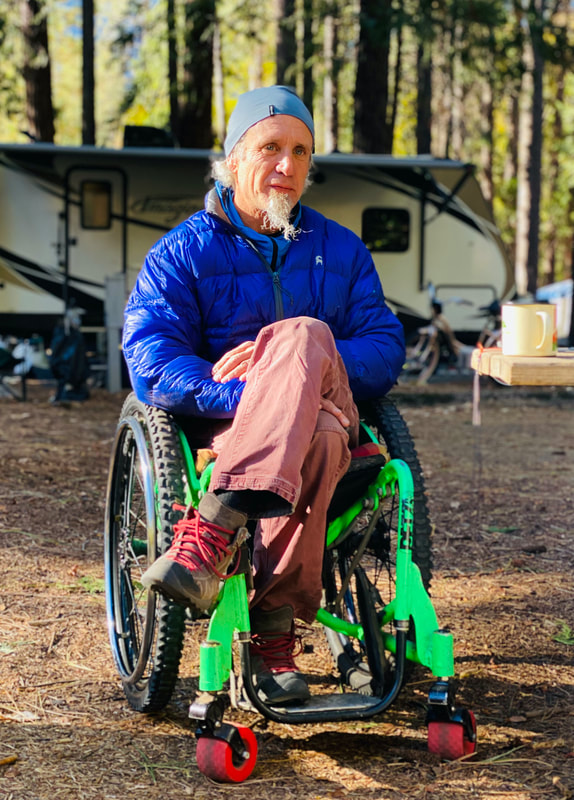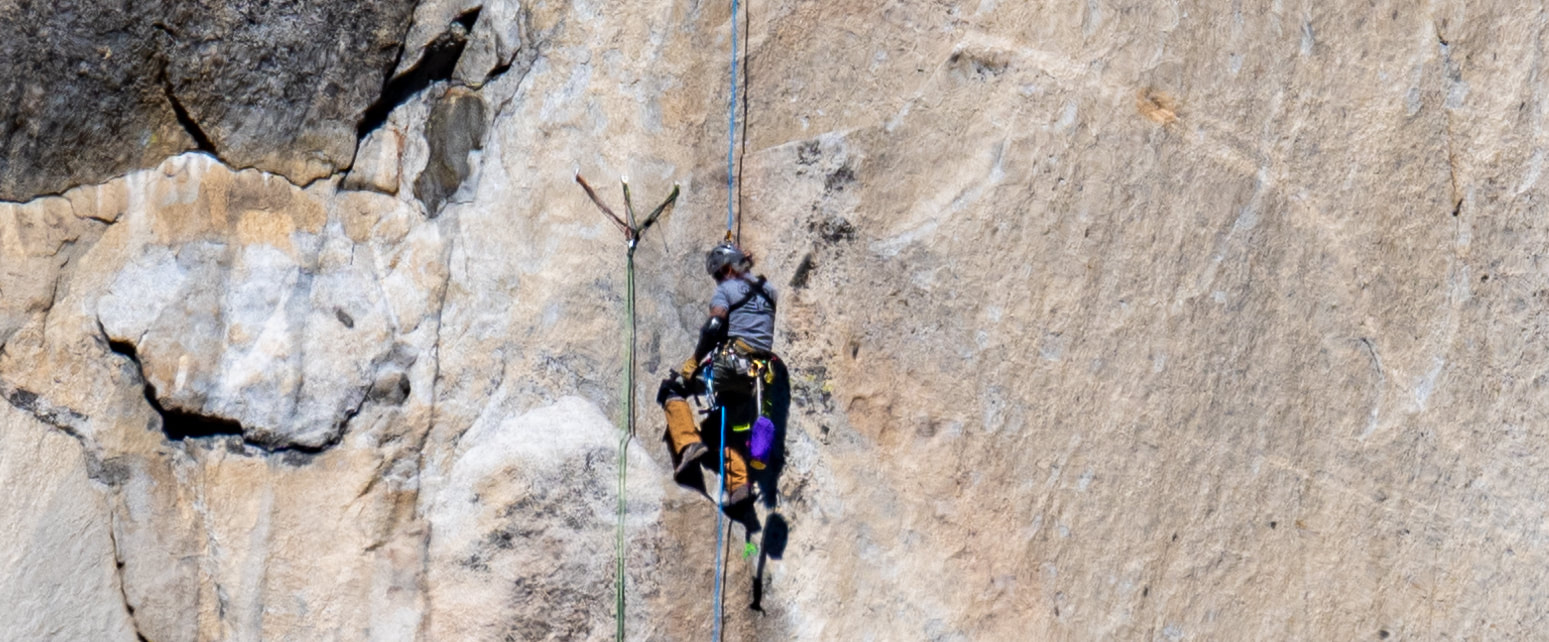Cover Photo: Kara Capaldo*
|
"I failed."
Those are the words I heard repeated multiple times in my conversation with Rand Abbott, one of the few adaptive lead aid climbers in the world. Rand was referring to his first attempt to be the only adaptive climber to lead The Nose on El Capitan. When Rand said, "I failed," though, it wasn't with a tone of defeat; It was with a tone of "fact" - like taking ownership. By this time - at the end of November 2021 - nearly two months after The Nose attempt, Rand had processed what happened. He had transitioned from the natural emotions of anger and disappointment to feelings of acceptance, identifying the lessons learned, and now creating a new plan and next steps to achieve his long-time goal. In our conversation, Rand recalled words from his good friend and Yosemite stonemaster Jim Bridwell. Rand explained that years ago, not long after he started climbing again after his spinal cord injury and was feeling a sense of defeat while re-learning how to climb without the use of his legs, Jim told him, "If you are pushing the limits in climbing two things are guaranteed - you will fail and you will get hurt." Those words helped push Rand beyond a suicidal frame-of-mind, when his world was turned into one of constant pain from nerve damage and new life in a wheel chair. |
Rand has had no shortage of failure and injury in his many years of putting up almost 700 First Adaptive Ascents (FAAs) and First Ascents (FAs) in Joshua Tree National Park, as well as, climbing every 5.12, 5.13, and 5.14 in the park. Rand shared a story about a 35-foot fall he took in 2018 after a flake broke off during an FA/FAA in Joshua Tree. In addition to losing the pieces he had in the now-absent flake, three pieces popped below him, shattering fragile rock that could take his weight but not the force of a fall. Rand cracked his helmet, became momentarily unconscious, fractured his collar bone and scapula, and dislocated his right shoulder. After he healed, Rand was back on the rock.
Pushing the limits is exactly what Rand does and climbing The Nose - for anybody, be it via aid or free climbing - is a boundary pusher. At 2,900 feet, The Nose is a big wall climb, taking most people at least several days, if not an entire week, to complete. Rand allotted fourteen days for his attempt recognizing the additional time it takes to determine his own beta.
Coordinating the logistics of a big wall climb is significant - food, water, bivvying, weather, climbing gear, and people. Coordinating for a fourteen-day effort and supporting a climbing attempt that has never been done, is even more challenging. This "failure" only reveals how much limit-pushing is being done here.
Coordinating the logistics of a big wall climb is significant - food, water, bivvying, weather, climbing gear, and people. Coordinating for a fourteen-day effort and supporting a climbing attempt that has never been done, is even more challenging. This "failure" only reveals how much limit-pushing is being done here.
The Team
Unless you are free soloing, climbing is not a solo sport, involving at least a team of two. And, to pull off the first paraplegic lead ascent of The Nose the team should at least be four on the rock - according to Rand's experience and initial calculations. Rand assembled and began training with a team over a year ago so they would understand how he climbs, his needs for climbing, how they can best support him in planning specifically for The Nose.
The planning was meticulous, looking at topos, detailed photos, videos, and beta for each pitch. They determined which pitches appeared to be best for Rand to lead, knowing his strengths, limitations, and skill set. Cracks needed to be continuous enough for pro placement or the face featured enough for aid gear. Bolt ladders also need to be close enough for Rand to reach. Most aid bolt ladder distances are set for able bodied climbers where, when standing up they are able to reach the next bolt. But as a paraplegic unable to stand, Rand has a much shorter reach distance to work with and all upward movement has to be done with his arms. To compensate Rand either uses a stick clip or will place additional aid gear, like rurps and beaks in between, to get to next bolt.
The planning was meticulous, looking at topos, detailed photos, videos, and beta for each pitch. They determined which pitches appeared to be best for Rand to lead, knowing his strengths, limitations, and skill set. Cracks needed to be continuous enough for pro placement or the face featured enough for aid gear. Bolt ladders also need to be close enough for Rand to reach. Most aid bolt ladder distances are set for able bodied climbers where, when standing up they are able to reach the next bolt. But as a paraplegic unable to stand, Rand has a much shorter reach distance to work with and all upward movement has to be done with his arms. To compensate Rand either uses a stick clip or will place additional aid gear, like rurps and beaks in between, to get to next bolt.
|
Between the prep with the team and the daily workouts Rand had been doing for nine months - 1000 pull ups, 1000 dips, and 45 miles on a hand cycle every day - along with making camping, trailer, and all other reservations, Rand felt ready. He pulled the trigger for The Nose. The trigger involved partnering with a film crew, making announcements to media, and doing a Go Fund Me campaign to help offset costs (which raised just over $6,000 towards the $22,000 Rand had paid out of pocket to date.) Then as the days to the big event grew closer, team members began backing out one-by-one, until none of the original team members remained only a few days before the climb.
This was a devastating blow, but Rand felt that with the training and planning he had already done, if he had a crew who was experienced with The Nose, it could still work. Five new team members joined in - all of whom had extensive experience with The Nose and skills like search and rescue: Joe Marely, Justin Lawrence, Josh Fengal, and Scott "Plaid" Peterson. It seemed that one wrench in the system had been removed, but numerous additional wrenches eventually presented themselves. The next wrench was when one of the new team members, Scott "Plaid" Peterson, suffered a hernia while helping haul gear prior to Rand's climbing. Plaid needed to have immediate surgery, which, fortunately, was successful. And, with the team's hard work, all 1000 pounds of gear was at Dolt Tower waiting for Rand. Enter wrenches number three and four. El Capitan and The Nose was a mad-house of climbers. It was nearly impossible to get into the queue, with climbers going up, groups coming down, and then some. After getting to Sickle Ledge, which was jam-packed crowded, Rand's new team wanted to make sure this effort succeeded. To do that, they felt they needed to get past the craziest sections lower down on the face. The meticulous planning Rand had been doing over the past year was being thrown out the window. |
The mantra became "get up to Dolt Tower as quickly as possible." To do this they proposed dropping lines down to Rand for him to jug up 1200 feet to Dolt. To put this into perspective, that means doing 1200 pull-ups in about 5-6 hours, navigating bolts where lines end, and transferring over the to the next static line, which is challenging for an adaptive climber.
|
But, with the bigger picture in mind, Rand reluctantly agreed. Jugging up lines someone else set up for him for the first half of the climb was not what he envisioned. Rand's original plan was to lead at least 13 of the 31 pitches and those pitches were carefully selected. Rand recognized the need for flexibility and, with still half the climb remaining, he knew he would be able to lead once they got to Dolt Tower.
The fourth wrench was the inexperience of the new team in working with Rand as a paraplegic climber. There were unrealistic expectations for the time, energy, and techniques needed for Rand to jug up 1200 feet. Loose hanging lines that twist and turn is a different ball game for a parapalegic. The work-around plan dealt with food, supplies, and estimates of speed for an able-bodied climber. Although Rand had been training 8-hours a day, doing a mind-blowing number of pullups and cardio, he hadn't been getting enough rest in the days leading up to or while jugging up to their new "point of departure" - Dolt Tower. Rand's body was taking a hit. Rand reached pitch four, pulled over the roof, and, although he was feeling strong, said he needed to lay flat to get the circulation back into his legs from constrictions in the harness. Then it happened - the final wrench - grand mal seizures. After Rand's spinal cord injury he began having seizures. He estimates he has probably had around 600 seizures since 2008. Lots of experimentation with pharmaceuticals have helped reduce the seizure frequency, but stress and physical exhaustion are two known triggers. Rand had been feeling extreme pressure to accomplish this climb that he set as a goal back in 2008. But Rand was not only climbing The Nose to meet his own goal, he also wanted to raise awareness for veteran suicide. Rand himself was suicidal in the early years after his spinal cord injury, and the fact that 22 soldiers die a day by their own hand is something that does not sit idle in Rand's heart. He wants to help save lives and show there is life after injury or combat. Upon his arrival in Yosemite, people had been approaching Rand offering to help carry things, thanking him for being a voice for veteran suicide, and sharing stories of their own experiences with suicide. Several people even drove in from other states just to witness the event. Add in stresses from the rescue and surgery needed for team mate Scott "Plaid" Peterson, the personal and fund-raised money spent up to this point, the filming that was taking place, the delays as a result of the crowds, and now the need to do a fast, unplanned jug up 1200 feet, it all added up in Rand's body. When Rand began experiencing severe seizures team member Joe Marley, gave Rand his seizure medicine and helped bring him back down - even while Rand was unconscious. Rand credits Joe for saving his life. Despite Yosemite Search and Rescue and paramedics recommending Rand go to the hospital, he opted to relax and sleep in his trailer for three days. Rand had dealt with enough seizures to know what he needed was rest. Plus, he wanted to hang out with those that stayed and enjoy the remaining time with the hard-to-come-by reserved camping spots. |
After resting Rand went climbing for two days in the Valley with his team, leading several climbs, including a 5.10d. This was the first opportunity for the newly assembled team to truly witness Rand's skilled climbing first-hand. Post-climb conversations yielded thoughtful reflections and Rand's team members acknowledged how their lack of experience climbing with him helped contribute to this outcome. They fully realized that this goal was not only about getting to the top of El Cap any way possible (i.e. to have Rand jug up), but that Rand is a key and skilled leader in this team. By Rand leading The Nose, they recognized that it sets a powerful precedent for climbers with disabilities.
In these conversations, they also reflected upon history, noting how it took numerous tries for people to get up El Capitan the first time - especially when the beta was unknown. Although the beta is well known now for the able-bodied leader, it is not known for a quadriplegic leader. Rand's ascent is new territory and delays should be expected - just like with any First Ascent. And, although only four people may be needed on the rock at a time, they also decided that the team needs to have at least 15-20 well-trained people to allow for the inevitable flux, switching members as needed to accommodate schedules and emergencies.
The experience was summed up by big wall climbers Steve Schneider and Mark Hudon. They have seen a lot of El Cap failures and in their eyes "this was a successful failure" - where everyone was capable of achieving the goal and everyone has learned critical new information to make it work next time.
In these conversations, they also reflected upon history, noting how it took numerous tries for people to get up El Capitan the first time - especially when the beta was unknown. Although the beta is well known now for the able-bodied leader, it is not known for a quadriplegic leader. Rand's ascent is new territory and delays should be expected - just like with any First Ascent. And, although only four people may be needed on the rock at a time, they also decided that the team needs to have at least 15-20 well-trained people to allow for the inevitable flux, switching members as needed to accommodate schedules and emergencies.
The experience was summed up by big wall climbers Steve Schneider and Mark Hudon. They have seen a lot of El Cap failures and in their eyes "this was a successful failure" - where everyone was capable of achieving the goal and everyone has learned critical new information to make it work next time.
A new, next-steps plan began to hatch as the days of conversation and climbing continued.
I think anyone who has met and climbed with Rand would say that they are confident he will see his vision through. Rand is known to surmount challenges. But as life teaches us, overcoming adversity never happens in one attempt - it is day after day of getting back up again. There is a saying, get up one more time than you have been knocked down. Add to that something Rand's friend Clark Jacobs told him once, "Rand, the rock doesn't give a shit if your legs don't work." And, as all climbers know, the rock is waiting for any and every attempt.
I think anyone who has met and climbed with Rand would say that they are confident he will see his vision through. Rand is known to surmount challenges. But as life teaches us, overcoming adversity never happens in one attempt - it is day after day of getting back up again. There is a saying, get up one more time than you have been knocked down. Add to that something Rand's friend Clark Jacobs told him once, "Rand, the rock doesn't give a shit if your legs don't work." And, as all climbers know, the rock is waiting for any and every attempt.
Also Check Out
*Kara Capaldo Photos
Kara Capaldo is a photographer from Santa Cruz, CA. She got her first camera at age ten and has been making pictures ever since. Photos give her a memory of the experience that she want to share with others. What was it like swimming with a 10-day old humpback when his mother swam up below him and nudged him towards her? She can share that with her photos. Photography is her excuse to travel the world to capture new experiences. Be it watching a family of lions or sitting and enjoying a sunset or up all night shooting the Milky Way, it’s all experiences that help her enjoy nature and our wonderful world.
WEBSITE: karacapaldo.com
INSTAGRAM: @karacapaldophotography
*Kara Capaldo Photos
Kara Capaldo is a photographer from Santa Cruz, CA. She got her first camera at age ten and has been making pictures ever since. Photos give her a memory of the experience that she want to share with others. What was it like swimming with a 10-day old humpback when his mother swam up below him and nudged him towards her? She can share that with her photos. Photography is her excuse to travel the world to capture new experiences. Be it watching a family of lions or sitting and enjoying a sunset or up all night shooting the Milky Way, it’s all experiences that help her enjoy nature and our wonderful world.
WEBSITE: karacapaldo.com
INSTAGRAM: @karacapaldophotography


